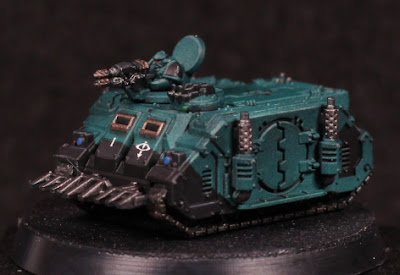 |
| Rhino to war. |
I could have posted earlier, but wanted to get the convoy finished up. No pictures of them all in a row because I don't have an appropriate background, but the idea is that two with the gunners and dozer blades are out the front, and the rest follow behind.
Ultimately I put far too much effort into these models, but they do look impressive all lined up. The main thing I would change is more shadow emphasis on the sides, and then recessed shading to give extra definition to the shapes. The models in general are uniformed in the colours, but I would like that to be slightly more the same shade. That's to be expected when using multiple Contrast layers over an uneven pre-highlight, which I'm sure will be improved on with a little more practice.
 |
| 4 exhausts must mean 4 engines. |
The black panelling was close to the usual grey black that I do, with one fewer step:
- Abaddon Black
- Corvus Black to highlight some panels, but mostly keeping it flat across surfaces.
- Dawnstone to edge highlight.
That's really all. The focus is on defining shapes, not smooth blends: the models are far too small for anything else to matter. The front viewports are framed to give some more visual interest and create a slight focal point, but the "glass" is simply black - there was no intention to try make it look anything different. All of the metal parts are also painted black around here, which makes the metallic paint show up better afterwards. The viewport edges themselves were going to be simply Castellax Bronze, but I decided it needed to be brightened up slightly and so Sycorax Bronze was layered over the top.
Most metal was painted in Iron Warriors, with the exception of the tracks which were Iron Hands Steel. The exhaust stacks were very slightly highlighted with a mix of Sycorax Bronze and Iron Warriors, but it's not visually significant.
Caledor Sky for the headlights, some red dots on targeting lenses, and Warpstone Glow on hatch lenses. The latter could've been brighter, but also isn't necessary at all. Again, with the size, no sense in trying to give them a reflective look unless it's being entered into a competition.
 |
| Captain Blackdoor. |
The final touches were decals of course, although a very (very) thin wash of black was added afterwards to tone down the otherwise bright white of those decals, and Wyldwood thinned with water and washed over the tracks. The intent was simply to muddy the tracks a little, make it seem like they've been driving over a battlefield and have picked up some dirt. I could have added some weathering as well, but it just doesn't seem worthwhile: the oil wash already dirties the tanks somewhat and gives them a used look.








